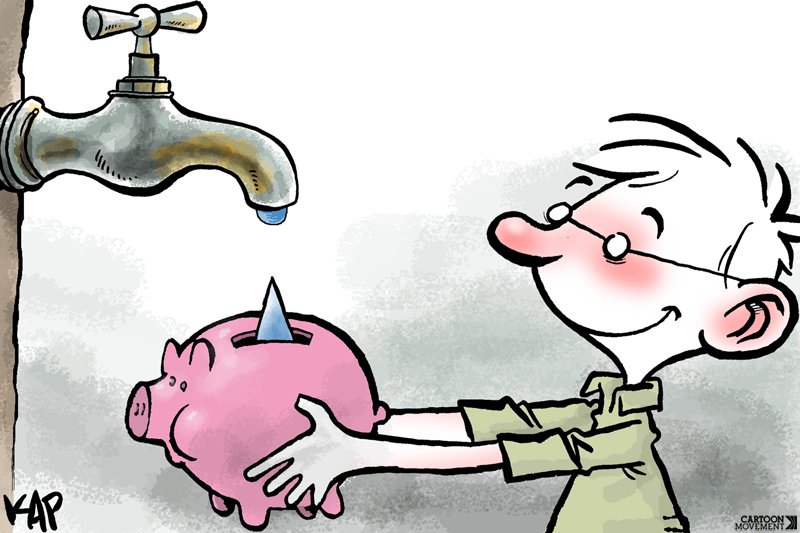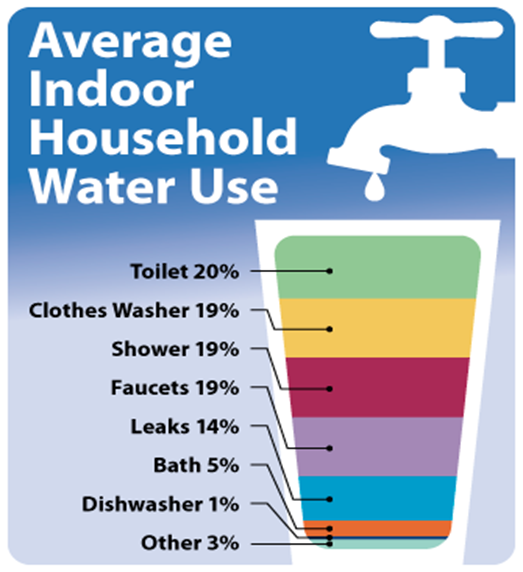The average American family of four uses 400 gallons of water per day. On average, approximately 70 percent of that water is used indoors, with the bathroom being the largest consumer (a toilet alone can use 27 percent!).
Old showers used to use up to 5 gallons of water per minute. Water-saving shower heads produce about 2 gallons per minute.
The average household’s leaks can account for more than 10,000 gallons of water wasted every year, or the amount of water needed to wash 270 loads of laundry.
Household leaks can waste more than 1 trillion gallons annually nationwide. That’s equal to the annual household water use of more than 11 million homes.
Ten percent of homes have leaks that waste 90 gallons or more per day.
Common types of leaks found in the home include worn toilet flappers, dripping faucets, and other leaking valves. All are easily correctable.
Fixing easily corrected household water leaks can save homeowners about 10 percent on their water bills.
Keep your home leak-free by repairing dripping faucets, toilet flappers, and showerheads. In most cases, fixture replacement parts don’t require a major investment.
Most common leaks can be eliminated after retrofitting a household with new WaterSense labeled fixtures and other high-efficiency appliances.
LEAK DETECTION:
• A good method to check for leaks is to examine your winter water usage. It’s likely that a family of four has a serious leak problem if its winter water use exceeds 12,000 gallons per month.
• Check your water meter before and after a two-hour period when no water is being used. If the meter does not read exactly the same, you probably have a leak.
• One way to find out if you have a toilet leak is to place a drop of food coloring in the toilet tank. If the color shows up in the bowl within 10 minutes without flushing, you have a leak. Make sure to flush immediately after this experiment to avoid staining the tank.
FAUCETS AND SHOWERHEADS:
• A leaky faucet that drips at the rate of one drip per second can waste more than 3,000 gallons per year. That’s the amount of water needed to take more than 180 showers!
• Leaky faucets can be fixed by checking faucet washers and gaskets for wear and replacing them if necessary. If you are replacing a faucet, look for the WaterSense label.
• A showerhead leaking at 10 drips per minute wastes more than 500 gallons per year. That’s the amount of water it takes to wash 60 loads of dishes in your dishwasher.
• Most leaky showerheads can be fixed by ensuring a tight connection using pipe tape and a wrench. If you are replacing a showerhead, look for one that has earned the WaterSense label.
TOILETS:
• If your toilet is leaking, the cause is often an old, faulty toilet flapper. Over time, this inexpensive rubber part decays, or minerals build up on it. It’s usually best to replace the whole rubber flapper—a relatively easy, inexpensive do-it-yourself project that pays for itself in no time.
• If you do need to replace the entire toilet, look for a WaterSense labeled model. If the average family replaces its older, inefficient toilets with new WaterSense labeled ones, it could save 13,000 gallons per year. Retrofitting the house could save the family nearly $2,400 in water and wastewater bills over the lifetime of the toilets.
OUTDOORS:
• As much as 50% of the water we use outdoors is wasted from inefficient watering methods and systems.
• An irrigation system should be checked each spring before use to make sure it was not damaged by frost or freezing.
• An irrigation system that has a leak 1/32nd of an inch in diameter (about the thickness of a dime) can waste about 6,300 gallons of water per month.
• In dry climates such as the Southwest, a household’s outdoor water use can be as high as 60 percent. In addition, some experts estimate that as much as 50 percent of water used for irrigation is wasted due to evaporation, wind, or runoff caused by inefficient irrigation methods and systems
• It’s usually not necessary to water grass every day. Instead, test your lawn by stepping on a patch of grass; if it springs back, it doesn’t need water.
• To ensure that your in-ground irrigation system is not leaking water, consult with a WaterSense irrigation partner who has passed a certification program focused on water efficiency; look for a WaterSense irrigation partner.
• Check your garden hose for leaks at its connection to the spigot. If it leaks while you run your hose, replace the nylon or rubber hose washer and ensure a tight connection to the spigot using pipe tape and a wrench.
• WaterSense labeled irrigation controllers tailor watering schedules to local weather conditions. The average family can save nearly 9,000 gallons of water annually by replacing a standard clock timer controller with a WaterSense labeled model.
Source: https://www.cityofjal.us/
Dear User/Visitor! Please, answer on our questions: tick off one of the positions – your answer will make us able to improve our site and make it more interesting and useful!



